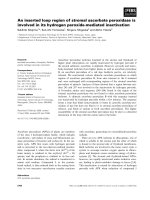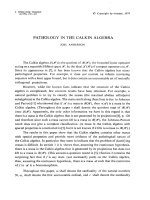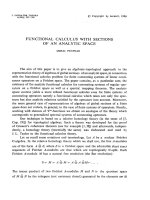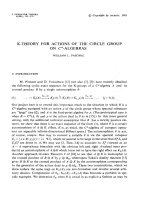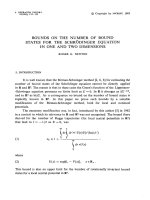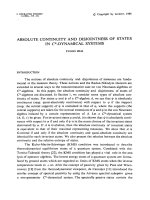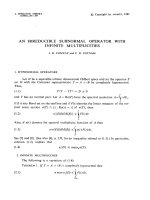Báo cáo toán học: "An Infinite Antichain of Permutations" ppsx
Bạn đang xem bản rút gọn của tài liệu. Xem và tải ngay bản đầy đủ của tài liệu tại đây (62.87 KB, 4 trang )
An Infinite Antichain of Permutations
Daniel A. Spielman
Department of Mathematics
Massachusetts Institute of Technology
Cambridge, MA 02139
Mikl´os B´ona
Department of Mathematics
University of Florida
Gainesville FL 32605
Submitted February 28, 2000; Accepted March 2, 2000
AMS Classification numbers: 05A05, 06A07
Abstract
We constructively prove that the partially ordered set of finite permutations ordered
by deletion of entries contains an infinite antichain. In other words, there exists an
infinite collection of permutations no one of which contains another as a pattern.
1 Introduction
When considering a partially ordered set with infinitely many elements, one should wonder
whether it contains an infinite antichain (that is, a subset in which each pair of elements
are incomparable). It is well known that all antichains of N
k
(where (x
1
,x
2
, ···,x
k
) ≤
(y
1
,y
2
, ···,y
k
) if and only if x
i
≤ y
i
for 1 ≤ i ≤ k ) are finite. (See p. 135 of [1]). Another
basic result is that all antichains of the partially ordered set of the finite words of a finite
alphabet are finite, where x<yif one can delete some letters from y to get x. (This result
is due to Higman and can be found in [1], pp. 106–107).
In this paper we examine this question for the partially ordered set P of finite permu-
tations with the following < relation: if m is less than n,andp
1
is a permutation of the
set {1, 2, ···,m} and p
2
is a permutation of the set {1, 2, ···,n},thenp
1
<p
2
if and only
1
the electronic journal of combinatorics 7 (2000), #N2 2
if we can delete n − m elements from p
2
so that when we re-name the remaining elements
according to their rank, we obtain p
1
. In the well-known terminology of
pattern-avoidance, this amounts to saying that p
1
<p
2
if and only if p
1
is a pattern of
p
2
. For example, 1 3 2 < 24531aswecandelete 4and 1 fromthelatter toget 253,which
becomes 1 3 2 after re-naming. Another way to view this relation is that p
1
<p
2
if there are
n − m elements of p
2
that we can delete so that the i-th smallest of the remaining elements
precedes exactly b
i
elements, where b
i
is the number of elements preceded by i in p
1
.Inother
words, the i-th smallest remaining entry of p
2
precedes the j-th one if and only if i precedes
j in p
1
. In short, p
1
<p
2
if p
1
is “contained” in p
2
, that is, there is a subsequence in p
2
in
which any two entries relate to each other as the corresponding entries in p
1
.
We would like to point out that any answer to this question would be somewhat surprising.
If there were no infinite antichains in this partially ordered set, that would be surprising
because, unlike the two partially ordered sets we mentioned in the first paragraph, P is
defined over an infinite alphabet and the “size” of its elements can be arbitrarily large. On
the other hand, if there is an infinite antichain, and we will find one, then it shows that this
poset is more complex in this sense than the poset of graphs ordered by the operations of
edge contraction and vertex deletion. (That this poset of graphs does not contain an infinite
antichain is a famous theorem of Robertson and Seymour [2, 3]). This is surprising too, as
graphs are usually much more complex than permutations.
2 The infinite antichain
We are going to construct an infinite antichain, {a
i
}. The elements of this antichain will
be very much alike; in fact, they will be identical at the beginning and at the end. Their
middle parts will be very similar, too. These properties will help ensure that no element is
contained in another one.
Let a
1
=13, 12, 10, 14, 8, 11, 6, 9, 4, 7, 3, 2, 1, 5. We view a
1
as having three parts: a de-
creasing sequence of length three at its beginning, a long alternating permutation starting
with the maximal element of the permutation and ending with the entry 7 at the fifth posi-
tion from the right (In this alternating part odd entries have only even neighbors and vice
versa. Moreover, the odd entries and the even entries form two decreasing subsequences so
that 2i is between 2i +5and2i +3),andaterminatingsubsequence3215.
the electronic journal of combinatorics 7 (2000), #N2 3
To get a
i+1
from a
i
, simply insert two consecutive elements right after the maximum
element m of a
i
, and give them the values (m − 4) and (m − 1). Then make the necessary
corrections to the rest of the elements, that is, increment all old entries on the left of m (m
included) by two and leave the rest unchanged (see Figure 1).
Thus the structure of any a
i+1
is very similar to that of a
i
—only the middle part becomes
two entries longer.
a
8
13
12
10
14
11
6
4
9
7
3
5
1
2
1
11
6
4
9
7
3
2
1
5
8
12
14
16
15
10
13
a
2
Figure 1: The pattern of a
i
We claim that the a
i
form an infinite antichain. Assume by way of contradiction that
there are indices i, j so that a
i
<a
j
. How could that possibly happen? First, note that
the rightmost element of a
j
must map to the rightmost element of a
i
, since this is the only
element in a
j
preceded by four elements less than itself. Similarly, the maximal element of
a
j
must map to the maximal element of a
i
, since, excluding the rightmost element, this is
the only element preceded by three smaller elements. This implies that the first four and
the last six elements of a
j
must be mapped to the first four and last six elements of a
i
,thus
none of them can be deleted.
Therefore, when deleting elements of a
j
in order to get a
i
, we can only delete elements
from the middle part, M
j
. We have already seen that the maximum element cannot be
deleted. Suppose we can delete a set
D of entries from M
j
so that the remaining pattern is a
i
. First note that D cannot
the electronic journal of combinatorics 7 (2000), #N2 4
contain three consecutive elements, otherwise every element before those three elements
would be larger than every element after them, and a
i
cannot be divided in two parts with
this property. Similarly, D cannot contain two consecutive elements in which the first is
even. Thus D can only consist of separate single elements (elements whose neighbors are
not in D) and consecutive pairs in which the first element is odd. Clearly, D cannot contain
a separate single element as in that case the middle part of resulting permutation would
contain a decreasing 3-subsequnce, but the middle part, M
i
,ofa
i
does not. On the other
hand, if D contained two consecutive elements x and y so that x is odd, then the odd element
z on the right of y would not be in D as we cannot have three consecutive elements in D,
therefore z would be in the remaining copy of a
i
and z wouldn’t be preceded by two entries
smaller than itself. This is a contradiction as all odd entries of M
i
have this property.
This shows that D is necessarily empty, thus we cannot delete any elements from a
j
to
obtain some a
i
where i<j.
We have shown that no two elements in {a
i
} are comparable, so {a
i
} is an infinite
antichain. So there exists an infinite collection of permutations no one of which contains
another as a pattern.
References
[1] M. Lothaire, “Combinatorics on Words” pp. 106-107, Addison-Wesley, 1983
[2] N. Robertson, P.D. Seymour, Graph Minors VIII. A Kuratowski theorem for general
surfaces, Journal of Combinatorial Theory, series B, 48, 255-288.
[3] N. Robertson, P.D. Seymour, Graph Minors XX. Wagner’s Conjecture, Journal of Com-
binatorial Theory, series B, to appear.
